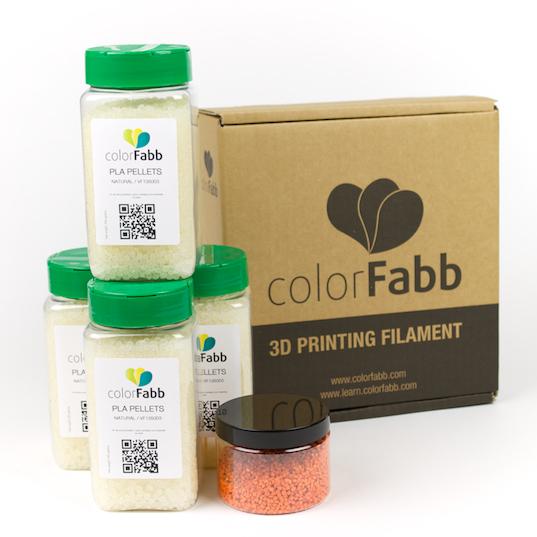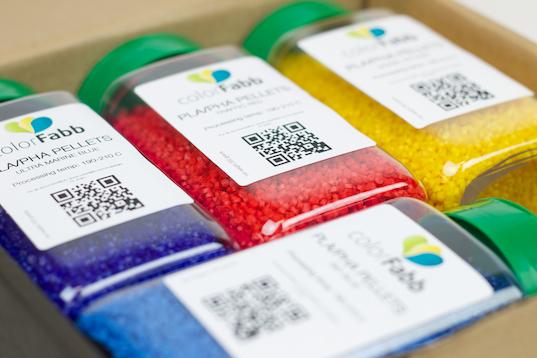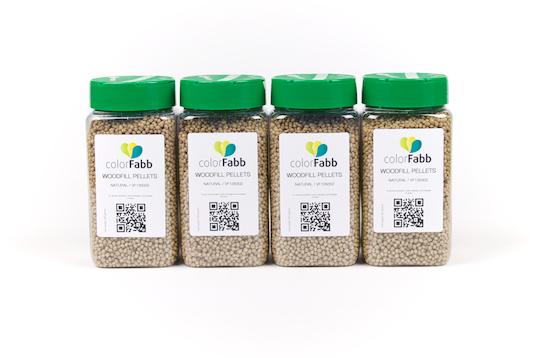There seems to be a movement, one in which hopes to make 3D printing both more green, as well as more friendly to our precious wallets. Individuals and larger companies are realizing that 3D printer filament is extremely pricey. So much so, that it has turned many people off from purchasing a 3D printer altogether. However, many people realize that the cost of purchasing pelletized materials is a heck of a lot cheaper than traditional spooled filament. A company that most of us in the 3D printing world have heard of, colorFabb, is taking a step in a new direction, with an announcement today.
colorFabb has announced that they have begun to offer their unique 3D printing materials in pellet form. The company began to offer these products early this morning, and will start by making 5 different products available: Pre-colored PLA/PHA, PLA/PHA, PLA, woodFill, and XT-copolyester.
“With this new product we are of course aiming primarily at the DIY filament producers who own a small DIY filament extruder (like a filabot etc..) but also other 3D filament production start-ups can be served in the future with materials and specific colorants (masterbatches),” stated colorFabb CEO Ruud Rouleaux
 In order to use pellets to 3D print with, you must have access to a filament extruder such as the FilaBot or FilaStruder. These machines take in the raw materials, in this case the pellets, and spew out strands of filament. These strands may then be fed into a 3D printer to print with.
In order to use pellets to 3D print with, you must have access to a filament extruder such as the FilaBot or FilaStruder. These machines take in the raw materials, in this case the pellets, and spew out strands of filament. These strands may then be fed into a 3D printer to print with.
“The first product is a so called test pack in our trusted and well known colorFabb shipping box, that contains 4 jars of polymer pellets,” explained Rouleaux. “We have invested a lot of time and attention to make this an attractive and configurable box, so that the user can select several varieties of 3D printing materials to get started!”
The pricing of colorFabb’s new pelletized filament is much more affordable than that of their traditional spooled filament. For exampled, PLA/PHA spools cost €35.95 for 750 grams, while the pellet version of that same filament is only €25.00 for 1,200 grams. That’s a discount of over 50%. Similarly, 600 grams of their innovative woodFill spooled filament costs €39.95, but one can pick up 1200 grams of the pellet version for only €20.00.
colorFabb plans to begin offering all of their filament in pellet form over time. “Our full range of material innovations and standard printing materials will be become available step by step this year,” said Rouleux.
What do you think? Will you be more inclined to purchase filament in pellet form, and then do the work yourself, turning it into printable filament? Discuss in the colorFabb Pellet Filament forum thread on 3DPB.com
Subscribe to Our Email Newsletter
Stay up-to-date on all the latest news from the 3D printing industry and receive information and offers from third party vendors.
You May Also Like
Precision at the Microscale: UK Researchers Advance Medical Devices with BMF’s 3D Printing Tech
University of Nottingham researchers are using Boston Micro Fabrication‘s (BMF) 3D printing technology to develop medical devices that improve compatibility with human tissue. Funded by a UK grant, this project...
3D Printing Webinar and Event Roundup: April 21, 2024
It’s another busy week of webinars and events, starting with Hannover Messe in Germany and continuing with Metalcasting Congress, Chinaplas, TechBlick’s Innovation Festival, and more. Stratasys continues its advanced training...
3D Printing Webinar and Event Roundup: March 17, 2024
It’s another busy week of webinars and events, including SALMED 2024 and AM Forum in Berlin. Stratasys continues its in-person training and is offering two webinars, ASTM is holding a...
3D Printed Micro Antenna is 15% Smaller and 6X Lighter
Horizon Microtechnologies has achieved success in creating a high-frequency D-Band horn antenna through micro 3D printing. However, this achievement did not rely solely on 3D printing; it involved a combination...
































